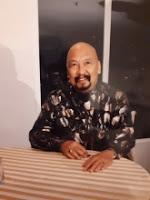As filmmaker, Ramon Estella was acclaimed. In the late ’30s, ’40s and ’50s, he directed such important films as Buenavista, Huling Habilin, Voice of Freedom, Sundalong Talahib, Desperado and Buhay at Pag-ibig ni Dr. Jose Rizal.
Buenavista merited Estella the Director of the Year (1941) award from the Philippine Cinema and Radio. Rosa del Rosario was named Actress of the Year for the same film.
Desperado was FAMAS Best Picture, Editor and Director for 1956.
Buhay At Pag-ibig Ni Dr. Jose Rizal is a three-hour epic which depicted major events in the life of the National Hero, shown in 1956.
But as a painter, little is written about Estella, although his exhibits were acclaimed here and abroad, including the United States. Estella was described as purveyor of modern art, culture and antiquities.
In the late ’50s, Estella left for New York to study film and television courses under top directors. He also worked for the United Nations and directed documentaries, TV shows and newsreels. His UN job brought him to Latin America and some parts of Asia, among them Singapore and Malaya.
Estella died of cancer of the liver on May 4, 1991.
Filmography
1933 – Ang Punyal na Ginto (actor)
1938 – Bayan at Pag-ibig [Excelsior] (dir)
1939 – Ruisenor [Parlatone]
1940 – Buenavista ? (dir)
1942 – Huling Habilin ?
1941 – Kundiman [Excelsior]
1941 – Singsing na Pangkasal [Acuna-Zaldariaga]
1941 – Paraiso [Excelsior] (dir)
1941 – Ilang-Ilang [Lvn] (dir)
1946 – Angelus [Lvn] (dir)
1947 – Caprichosa [Premiere] (dir)
1948 – Ang Anghel sa Lupa [Premiere] (dir)
1948 – Perfidia [Premiere] (dir)
1948 – Labi ng Bataan [Premiere] (dir)
1948 – Hiram na Pangalan [Premiere] (dir)
1949 – Lihim na Bayani [Premiere] (dir)
1949 – Kay Ganda ng Umaga [Premiere] (dir)
1949 – Dugo ng Katipunan [Premiere] (dir)
1950 – Sundalong Talahib [Filipinas] (dir)
1950 – Kenkoy [Premiere] (dir)
1950 – Punglo at Pag-ibig [Premiere] (dir)
1950 – Bandido [Premiere] (dir)
1950 – Prinsipe Don Juan [Premiere] (dir)
1956 – Desperado [People's] (dir)
1956 – Buhay at Pag-ibig ni Dr. Jose Rizal [Balatbat & Bagumbayan] (dir)
1957 – Kim [C.Santiago Film Org] (dir)
1958 – Sta. Rita de Casia [Premiere] (dir)
1958 – Ramir [Everlasting] (dir)
Filmography in Singapore / Malaya
1. 1957 / Kembali Saorang / One Came Back / Ramon Estella / Malay Film Productions
2. 1958 / Anak Pontianak / Son of Pontianak / Ramon Estella / Malay Film Productions
3. 1958 / Matahari/ The Rape of Malaya / Ramon Estella / Malay Film Productions
4. 1959 / Saudagar Minyak Urat / Love Crazy / Ramon Estella / Malay Film Productions
5. 1959 / Samseng / Gangster / Ramon Estella / Malay Film Productions
6. 1963 / Raja Bersiong / King of Dracula / Ramon Estella / Cathay-Keris
7. 1963 / Darah-Ku / My Blood / Ramon Estella / Maria Menado Productions, Cathay-Keris
8. 1963 / Bunga Tanjong / Cape of Flowers / Ramon Estella/ Maria Menado Productions, Cathay-Keris
9. 1964 / Pontianak Kembali / The Pontianak Returns / Ramon Estella / Maria Menado Productions, Cathay-Keris
10. 1964 / Melanchong ka-Tokyo / Holiday in Tokyo / Ramon Estella / Malay Film Productions
11. 1964 / Dupa Chendana / The Enchanted Island / Ramon Estella / Malay Film Productions
12. 1965 / Pusaka Pontianak / The Accursed Heritage / Ramon Estella / Malay Film Productions















































